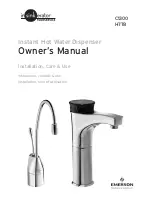
36
The perimeter hot tube is not replaceable. In the unlikely
event of a leak in the hot tube, a kit is available to bypass
the hot tube in the sealed system. An electrical heater
wire must be installed within the tubing. Refer to the
appropriate parts list of the model being serviced for the
correct kit part number. See the procedure at the end of
this section to install an electric heater.
REFRIGERANT CYCLE
The refrigerant cycle is a continuous cycle that occurs
whenever the compressor is in operation. Liquid
refrigerant is evaporated in the evaporator by the heat
that enters the cabinet through the insulated walls, and
by the heat from product load and door openings. The
refrigerant vapor is then drawn from the evaporator,
through the suction line, to the compressor.
Compression raises the pressure and temperature of the
vapor in the compressor, and the vapor is then forced
through the discharge valve into the discharge line and
into the condenser. Air passing over the condenser
surface removes heat from the high pressure vapor
which then condenses to a liquid. The liquid refrigerant
then flows from the condenser to the evaporator, through
the small diameter liquid line (capillary tube). Before it
enters the evaporator, the liquid refrigerant is
sub-cooled in the heat exchanger by the low temperature
suction vapor in the suction line.
LOW OR HIGH-SIDE LEAK OR UNDERCHARGE
A loss of refrigerant can result in any of the following:
1. Excessive or continuous compressor operation.
2. Above normal freezer compartment temperature.
3. A partially frosted evaporator (depending on amount
of refrigerant loss).
4. Below normal freezer compartment temperature.
5. Low suction pressure (vacuum).
6. Low wattage.
The condenser will be “warm to cool”, depending on
the amount of refrigerant lost.
When refrigerant is added, the frost pattern will improve,
the suction and discharge pressures will rise, the
condenser will become hot and the wattage will
increase.
In the case of a low side refrigerant leak, resulting in
complete loss of refrigerant, the compressor will run, but
will not refrigerate. Suction pressure will drop below
atmospheric pressure and air and moisture will be drawn
into the system, saturating the filter drier.
If a slight undercharge of refrigerant is indicated, and no
leak can be found after a thorough leak test, the charge
can be corrected without changing the compressor.
If there is reason to believe the system has operated for
a considerable length of time with no refrigerant, and the
leak occurred in the evaporator, excessive amounts of
SOLDERING
WARNING: WEAR APPROVED SAFETY
GLASSES WHEN WORKING WITH OR ON
ANY PRESSURIZED SYSTEM OR
EQUIPMENT. HAVE AN APPROVED DRY TYPE
FIRE EXTINGUISHER HANDY WHEN USING
ANY TYPE OF GAS OPERATED TORCH.
1. All joints to be soldered must have proper fit.
Clearance between tubes to be soldered should be
from .001” to .006”. It is not practical to actually
measure this; however, you do not want a dry fit or
loose fit. Tubing joints should overlap about the
distance of their diameter except for restrictor tubes,
which should be inserted 1.25”
2. Clean all joint areas with fine steel wool or,
preferably, an abrasive cloth, such as grit cloth No.
23 or Scotch-Brite.
3. Apply thin film of liquid flux recommended for silver
soldering to surfaces to be joined, and to surfaces
immediately adjacent to joint.
4. Align tubing so no stress is on joint. Do not move
tubing while solder is solidifying or leaks will result.
CAUTION: During application of heat, use wet
cloths to prevent heat from conducting to
areas other than soldered joint. Use a sheet
of metal as a heat deflector to keep flame
away from inflammable materials and
painted surfaces.
5. Use a torch of adequate capacity so joint can be
quickly heated with a minimum of heat travel to
other points. Use a good grade of silver solder.
6. Solder connections. If tubing is properly cleaned
and fluxed, solder will flow readily. Use only enough
solder to make a good bond.
7. Allow joint to cool, then wash exterior with water
to remove flux.
BASIC COMPONENTS
The basic components of a refrigerator are a
compressor, condenser, evaporator, heat exchanger
(capillary tube and suction line), drier, and perimeter hot
tube.
PERIMETER HOT TUBE
To reduce the possibility of condensation forming on the
exterior of the cabinet in high humidity areas, a perimeter
hot tube (refrigerant tube) has been installed in the unit.
The perimeter tube extends up the left side, across the
center mullion and down the right side and into the filter
drier. When the compressor operates, warm refrigerant
flows through the primary condenser, then, into the
primary hot tube, warming the cabinet front exterior.
Summary of Contents for BEVERAGE CENTER II
Page 22: ......
Page 33: ...32 COMPRESSORWIRING Induction Run Compressor with Relay LADDER SCHEMATIC ...
Page 34: ...33 WIRING DIAGRAM ...
Page 61: ...60 ...
Page 62: ...61 ...
Page 63: ...62 ...
Page 64: ...63 ...
Page 65: ...64 ...
Page 66: ...65 ...
Page 68: ...67 Step 3 Step 4 Step 5 Step 6 ...
Page 69: ...68 Step 8 Step 7 Step 9 Step 10 ...
Page 70: ...69 Ice Maker Exploded View ...
Page 71: ...70 Ice Maker Wiring Diagrams Enlarged view ...
Page 77: ......
















































